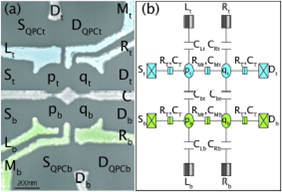 The group pioneered some of the early work on quantum dots. Using gates on a GaAs GaAlAs heterostructure it is possible to trap single electrons in a potential well defined by a combination of the semiconductor layers and voltages applied to the gates. By defining a 1-D channel next to the dots we are able to measure single electron movement into and out of the dots.
The group pioneered some of the early work on quantum dots. Using gates on a GaAs GaAlAs heterostructure it is possible to trap single electrons in a potential well defined by a combination of the semiconductor layers and voltages applied to the gates. By defining a 1-D channel next to the dots we are able to measure single electron movement into and out of the dots.
Recently we have demonstrated a cellular automata device which consists of four dots and two detectors. We are looking at the interactions between one pair of dots and its neighbour. When we polarize one pair of dots, the interaction with its neighbour causes that pair of dots to polarize, this process has been proposed as a new form of computing architecture. Coupling such as this has been proposed as a technique for reducing dephasing so that such a structure could form the basis of a quantum computer with long coherence times.
In addition we have been making these structures free-standing so that we can quantise the phonons and modify the electron-phonon interactions.
